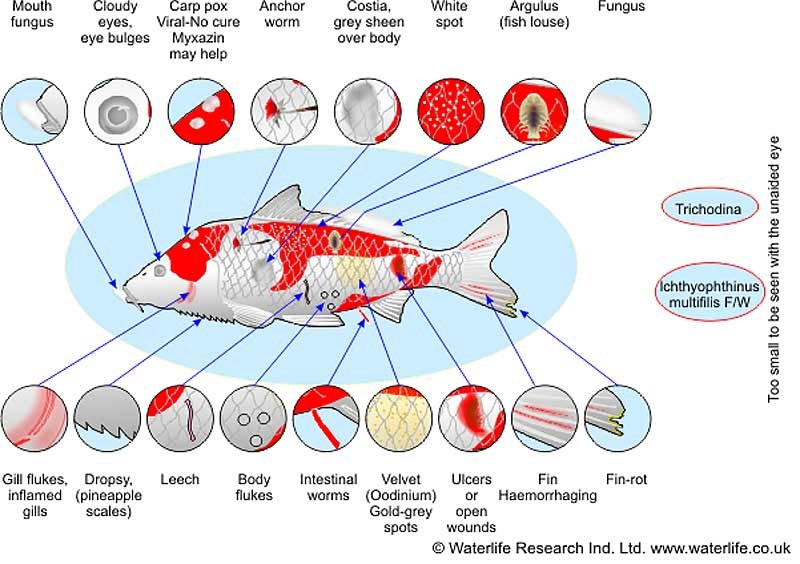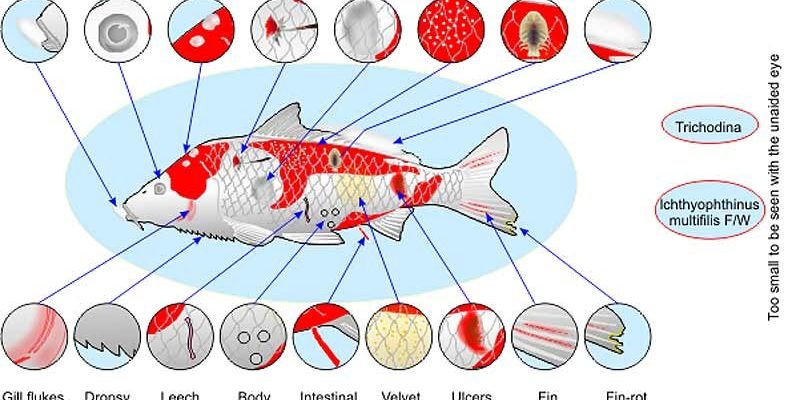
Let’s dive into the world of Koi diseases. It’s a topic that can seem overwhelming at first, but understanding the common diseases, their symptoms, and prevention methods can make a huge difference in keeping your fish happy and thriving. You’ll see that with a bit of knowledge and care, you can help your Koi live their best lives—a kind of fishy healthy lifestyle, if you will.
Understanding Common Koi Diseases
When it comes to Koi fish, several diseases can pop up, just like how cats can catch a cold or dogs can get fleas. Some diseases are caused by parasites, while others are linked to bacteria or fungi. Here’s a closer look at some of the common culprits.
First off, let’s talk about Ichthyophthirius multifiliis, commonly known as “Ich.” It’s a nasty little parasite that manifests as white spots on the skin, fins, and gills of your fish. You might think of it as “fish freckles,” but trust me, they’re not cute! If you notice your Koi rubbing against rocks or plants, it’s a telltale sign they might have Ich.
Signs of Ich in Koi
– White Spots: Small white cysts appear on the body and fins.
– Rubbing or Scratching: Koi may brush against objects to relieve irritation.
– Lethargy: Affected fish may become less active and spend more time at the bottom of the pond.
Preventing Ich and Other Parasites
Here’s the thing: prevention is your best friend when it comes to Koi health. Keeping your pond clean and your fish stress-free can go a long way in avoiding Ich and similar diseases. Here are a few effective prevention tips:
- Maintain Water Quality: Regularly test your pond water for ammonia, nitrite, and pH levels. Clean water is essential for healthy fish.
- Introduce Fish Carefully: Quarantine new fish for a few weeks before adding them to your pond. This helps prevent the spread of potential diseases.
- Avoid Overcrowding: Make sure not to overcrowd your pond. More fish mean more waste, which can lead to poor water quality and increased stress.
Understanding Bacterial Infections
Bacterial infections are another concern for Koi fish. One of the most common types is Aeromonas hydrophila, which can affect Koi in warm water conditions. You might notice skin ulcers or lesions, which can be alarming. These infections typically arise when the fish are already stressed—maybe due to poor water quality or an injury.
Signs of Bacterial Infections
– Ulcers: Open sores or lesions on the skin.
– Red or Inflamed Areas: Skin may become discolored or swollen.
– Excessive Mucus: Sometimes Koi produce more slime, leading to a cloudy appearance.
How to Prevent Bacterial Infections
Keeping your Koi strong and healthy can help ward off bacterial infections. Here’s what you can do:
- Regular Health Checks: Observe your fish daily for any changes in behavior or appearance.
- Optimize Water Conditions: Regular water changes and maintaining proper filtration can reduce the risk of bacterial growth.
- Feed High-Quality Food: Well-nourished fish have better immune systems. Choose quality Koi food for optimal growth and resilience!
Fungal Infections and Their Prevention
Fungal infections can be tricky, often taking advantage of Koi that are stressed or weakened. One of the common types is Saprolegnia, a water mold that appears as white, cotton-like growths on the skin or gills. This often comes into play after physical injuries or poor water quality.
Signs of Fungal Infections
– Cotton-Like Growths: Visible white tufts on the skin or fins.
– Swollen Areas: Infected parts may become swollen or sensitive to touch.
– Loss of Appetite: Affected Koi may stop eating altogether.
Preventing Fungal Infections
Prevention is key here, just like with bacterial infections. Focus on these strategies to help keep fungi at bay:
- Promptly Treat Injuries: If your Koi gets injured, take quick action to treat the wound using appropriate methods.
- Keep Water Clean: Regular maintenance and proper filtering can limit fungal growth opportunities.
- Avoid Overfeeding: Excess food can pollute the water, creating a breeding ground for fungi.
Understanding Stress and Its Effects on Koi Health
Believe it or not, stress can have a massive impact on Koi health. Factors like poor water quality, overcrowding, or sudden temperature changes can leave your fish vulnerable to diseases like Ich, bacteria, and fungi. Think of stress as the underlying issue that makes it easier for diseases to take hold.
Signs of Stress in Koi
– Unusual Swimming Patterns: Fish may swim erratically or stay near the surface.
– Hiding: Koi might seek shelter or hide more than usual.
– Lethargy: Sluggish behavior can indicate stress.
Preventing Stress in Your Koi
To ensure your Koi are less likely to fall ill due to stress, consider these strategies:
- Regular Monitoring: Keep an eye on their behavior and surroundings.
- Adequate Space: Make sure your pond has enough room for all the fish to swim freely.
- Consistent Water Conditions: Aim for stable temperature and quality levels in your pond.
Wrapping Up on Koi Health
Caring for Koi fish means being proactive about their health. By recognizing the signs of common diseases and taking preventive measures, you can enjoy the beauty and tranquility these lovely creatures bring to your backyard. Remember, a little effort in maintaining water quality, managing stress, and observing your Koi can keep them swimming happily for years to come.
If you ever find yourself facing an issue, don’t hesitate to consult with a vet or a Koi specialist. They can provide tailored advice that ensures your Koi stay as vibrant as they were when you first brought them home. Happy Koi keeping!

